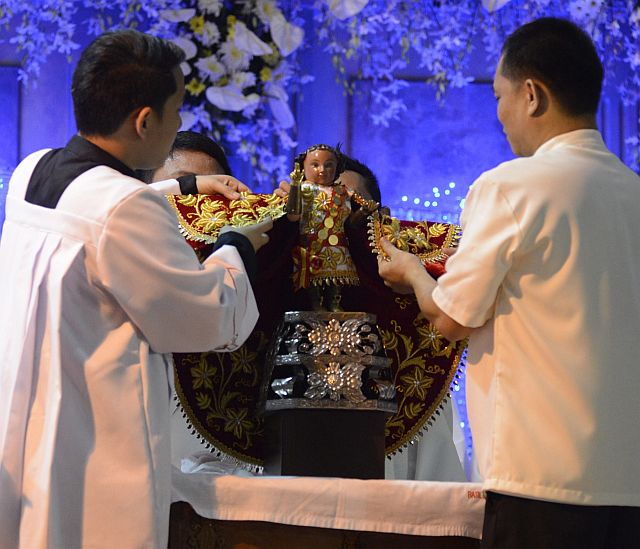
The Sto. Niño “Hubo” ritual is an annual event that takes place five days after the Feast of the Holy Child Jesus, Señor Sto. Niño. (CDN FILE PHOTO)
THE 452nd Fiesta Señor celebration officially ends tomorrow with the traditional “Hubo” or the changing of the vestments of the Sto. Niño de Cebu.
The ritual will take place during a Mass to be presided by Fr. Pacifico “Jun” Nohara Jr., the rector of the Basilica del Sto. Niño, at the Pilgrim’s Center at 4 a.m.
Fr. Ric Anthony Reyes, media liaison officer and head of the Fiesta Señor’s general secretariat, said Hubo used to be a private ritual but was integrated into the liturgy of the Holy Mass in 1990 to allow people to witness the event.
“As we close the Fiesta Señor, may we never let ourselves rest from the constant meditation on the Sto. Niño,” he said.
“The ritual of ‘Hubo’ has just returned us to the ordinariness of life. But it does not put an end to our piety and our devotion. May it deepen more, take root towards our hearts so that it may bear fruit abundantly,” he added.
A replica of the original Sto. Niño image will be stripped of its fiesta clothes, given a ritual bath, and fitted with simpler garments.
The ritual will begin with the removal of the crown, followed by the orb and scepter and armlet, the bands, cape, tunic, inner garments and boots.
For each piece of clothing removed, the rector will sing “Christe, exaudi nos” (Christ, graciously hear us) to commemorate the passion and death of Jesus Christ.
The image will be dipped in water, wiped with a towel and dressed in its ordinary garb, starting from his boots up to his crown.
For every piece donned, the faithful sing “Christus vincit, Christus regnat, Christus, Christus imperat (Christ conquers, Christ reigns, Christ commands),” in remembrance of Jesus’ glorious resurrection.
Digging into history books, Reyes said there are stories which narrate how Cebu’s Queen Juana, the first recipient and “owner” of the Sto. Niño, bathed the Holy Child and changed his clothes.
“When the Augustinians took care of the image as its custodians, they surely took care of the image as they changed the vest on a regular basis,” he said.
The changing of the dress of the original image was earlier made in a private ceremony called “Ilis” (to change) before the feast last Sunday.
The image, given by Portuguese explorer Ferdinand Magellan to Cebu’s Queen Juana in 1521, will remain inside the Sto. Niño Chapel of the basilica during the Hubo ceremony to be held at the Pilgrim’s Center outside the church.
Disclaimer: The comments uploaded on this site do not necessarily represent or reflect the views of management and owner of Cebudailynews. We reserve the right to exclude comments that we deem to be inconsistent with our editorial standards.




